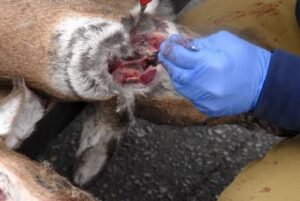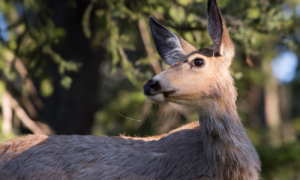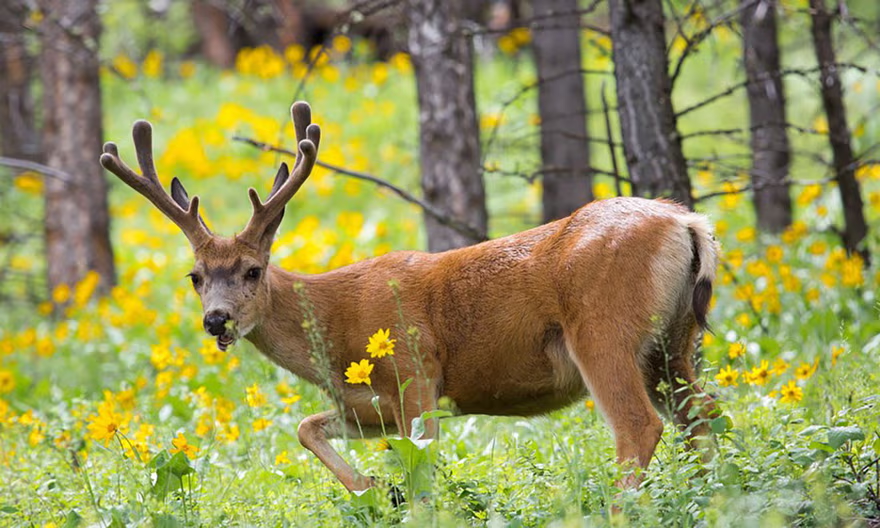Warnings that ‘slow-moving disaster’ in North America raises chances of fatal mad cow-type disease jumping the species barrier
When the donkey deer buck passed on in October, it died in a spot most people would consider the center of no place, miles from the closest street. In any case, its final gasps were not taken in a confined corner of American geology. It surrendered to a long-feared illness in the boondocks of Yellowstone public park, northwest Wyoming – the main affirmed instance of constant squandering sickness in the country’s most popular nature save.
For a long time, ongoing squandering sickness (CWD), brought about by prions – unusual, contagious pathogenic specialists – has been spreading covertly across North America, with worries voiced basically by trackers after spotting deer acting peculiarly.

The prions cause changes in the hosts’ cerebrums and sensory systems, leaving creatures slobbering, dormant, starved, staggering, and with an obvious “clear gaze” that drove some to refer to it as “zombie deer sickness”. It spreads through the cervid family: deer, elk, moose, caribou, and reindeer. It is deadly, with no known medicines or immunizations.
Its disclosure in Yellowstone, whose biological system upholds the best and most different cluster of huge wild well evolved creatures in the mainland US, addresses a significant public reminder, says Dr Thomas Roffe, a vet and previous head of creature wellbeing for the Fish and Natural life Administration, a US government organization.
“This case places CWD on the radar of far and wide consideration in manners it wasn’t previously – and that is, unexpectedly, something worth being thankful for,” he says. “An infection has immense natural ramifications.”
Roffe had been anticipating CWD would arrive at Yellowstone for a long time, cautioning that both the national government and the territory of Wyoming expected to go to forceful lengths to assist with easing back its spread. Those admonitions went generally unnoticed, he says, and presently the results will work out before the large numbers who visit the recreation area every year.
The region comprises an immense research center for seeing what happens when CWD invades an environment with its unique full supplement of natural variety. Countless elk and deer travel through Yellowstone, supporting populaces of mountain bears, wolves, cougars, coyotes, and different scroungers.
The illness is a “sluggish catastrophe”, as per Dr. Michael Osterholm, a disease transmission expert who concentrated on the flare-up of ox-like spongiform encephalopathy, or “distraught cow sickness” – a connected prion condition – in the UK, and is the overseer of the Middle for Irresistible Infection Exploration and Strategy at the College of Minnesota.
Dr Cory Anderson as of late acquired his doctorate examining with Osterholm, zeroing in on pathways of CWD transmission. “We’re managing an illness that is constantly lethal, hopeless, and exceptionally infectious. Heated into the concern is that we don’t have a viable simple method for killing it, neither from the creatures it taints nor the climate it defiles.”
When a climate is tainted, the microorganism is incredibly difficult to kill. It can endure for a long time in soil or on surfaces, and researchers report it is impervious to sanitizers, formaldehyde, radiation, and cremation at 600C (1,100F).
Jumping the species barrier

In the US and Canada, CWD has acquired consideration since it influences major game creatures as well as in light of the likelihood that it could bounce the species obstruction. Deer, elk, and moose could contaminate domesticated animals, different warm-blooded creatures, birds, or even people. Disease transmission experts say the shortfall of a “overflow” case yet doesn’t mean it won’t work out. CWD is one of a bunch of deadly neurological problems that incorporate BSE.
“The BSE [mad cow] flare-up in England gave an illustration of how, short-term, things can get insane when an overflow occasion occurs from, express, domesticated animals to individuals,” Anderson says. “We’re discussing the capability of something almost identical happening. Nobody is saying that it’s most certainly going to work out, yet individuals must be ready.”
Dr Raina Plowright, an infection biologist at Cornell College, says CWD ought to be seen against a scenery of perilous arising zoonotic microorganisms that are getting to and fro across species boundaries between people, domesticated animals, and natural life internationally. Episodes happen as human settlements and rural activities press further into conditions where contact with sickness-conveying creatures is expanding.
With the hunting season underway in the US, the US Communities for Infectious Prevention and individual states firmly suggest that reaped game creatures be tried for sickness and that meat from cervids that show up sick ought not to be consumed.
The Partnership for Public Natural Life assessed in 2017 that 7,000 to 15,000 CWD-contaminated creatures a year were accidentally being eaten by people, and that the number was supposed to increment by 20% every year. In Wisconsin, where testing of game meat is willful, Anderson and Osterholm say a huge number of individuals have most likely eaten meat from contaminated deer.
